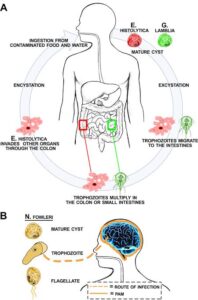Back to: MICROBIOLOGY 300 LEVEL
Welcome to class!
Hello my brilliant scholar! I’m so glad you’re here today—ready to grow your microbiology knowledge even more. You’ve been learning about parasites, and now we’re going to focus on some very sneaky and common ones that love to hide in the human intestine. Today’s topic is Nematodes: Ascaris, Hookworm, and Enterobius. These may sound like complicated names, but you’re going to see just how familiar they are—especially here in Nigeria and across Africa.
Nematodes: Ascaris, Hookworm, Enterobius
Nematodes, also called roundworms, are long, thin, unsegmented worms. They can live in the soil, water, plants, or inside the human body. Many children in rural and urban areas are affected by these worms—especially where sanitation is poor and walking barefoot or eating with unwashed hands is common. These parasites are tiny but powerful and can affect growth, learning, and general well-being.

Let’s look at the three main nematodes you need to know.
Ascaris lumbricoides (Roundworm)
One of the largest and most common intestinal worms in humans.
It looks like a pale earthworm and can grow up to 30 cm long.
Spread by the faecal-oral route—eggs are passed in faeces and swallowed through contaminated food, water, or dirty hands.
Once inside the body, the larvae travel through the lungs (causing coughing) before settling in the intestines.
Symptoms may include stomach pain, vomiting, bloated tummy, coughing, and in heavy infections—intestinal blockage.
Common in children who play in the sand or soil and put their fingers in their mouths.
Hookworm (Ancylostoma duodenale and Necator americanus)
These worms are small but dangerous because they suck blood from the walls of the intestines.
Transmitted by walking barefoot on contaminated soil—the larvae penetrate through the skin of the feet.
Once in the body, they also pass through the lungs before reaching the intestines.
Causes iron-deficiency anaemia, tiredness, weakness, and stunted growth in children.
You may also notice itching between the toes or on the feet—this is called “ground itch”.
Enterobius vermicularis (Pinworm)
Very tiny worm that mainly affects school-aged children.
Spread by ingesting eggs from contaminated fingers, bedding, clothing, or surfaces.
The female worm comes out at night to lay eggs around the anus, causing intense itching.
Children may scratch, then transfer eggs to others or reinfect themselves.
It’s easily spread in schools, homes, or anywhere there’s close contact.

Imagine you’re at your grandmother’s village and you’ve spent the day playing outside. You forget to wash your hands before eating, and the roundworm eggs from the soil enter your body. Or maybe you’re walking barefoot on wet sand, and hookworm larvae sneak in through your skin. These worms aren’t just “village problems”—they affect both city and rural areas, especially where hygiene isn’t strictly followed.
Summary
- Ascaris: large roundworm, spread by swallowing eggs in contaminated food/water.
- Hookworm: blood-sucking worms, enter through the feet; cause anaemia.
- Enterobius: tiny pinworm that causes itching around the anus, especially in children.
- All three are common where hygiene and sanitation are poor.
Evaluation
- What are nematodes, and where can they live?
- How is Ascaris lumbricoides transmitted?
- What is a major symptom caused by hookworm infection?
- Which nematode causes anal itching at night?
- Mention two ways to prevent infections by intestinal nematodes.
Great job today! You’re becoming a real expert on parasites—just imagine how much impact you can make with this knowledge. Remember, keeping clean hands, wearing shoes, and good hygiene are powerful tools against these worms. Keep shining, keep learning, and know that Afrilearn is with you every step of the way. You’re doing amazing—see you in the next exciting class!
